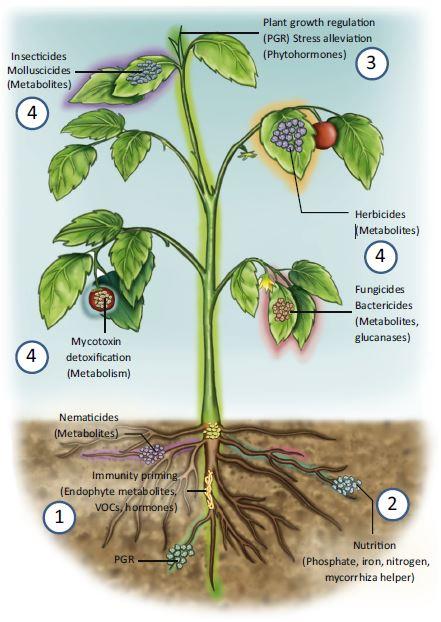
Credit: Rey and Dumas/Trends in Plant Science 2016
The bacteria Streptomyces–which is commonly used in human antibiotics and found in the natural environments of wild plants as well as crops–could be used as an environmentally friendly alternative to pesticides, scientists in France write in an Opinion published December 1 in Trends in Plant Science. In addition to protecting plants from fungal and other threats, Streptomyces has been shown to keep roots healthy and promote plant growth. Streptomyces or their derived metabolites are already being used in six different agricultural products.
"Streptomyces can really produce a wide diversity of molecules that have bioactive properties," says lead author Thomas Rey, Biofungicide Research Program Manager at the De Sangosse Group in France. "This is a unique microbial genus that can do so many different things for plants, and it has the potential to be a cornerstone for how we could protect crops in a sustainable fashion."
Streptomyces is most commonly found in the upper soil and inside plant roots, and it has primarily been used in antibiotics that treat serious infections such as tuberculosis. However, new advances in synthetic biology have allowed plant scientists to explore how they could rely on previous medical research to deploy Streptomyces strains for agriculture as well. Scientists know the microbe helps encourage the growth of plant roots and can control proliferation of plant pests in the soil. Additionally, Streptomyces can detoxify harmful mycotoxins, which are produced by certain fungi and can ruin large food yields from plants like grain or wheat.
"The soil around plants is rich in microbes that are amazingly diverse," says Rey. "But we still have to find ways to accurately study how these microbes and the substances they release both interact with the environment and different parts of the plant so that we can transfer that knowledge to crops that would really benefit from exposure to Streptomyces."
Rey and his team are aware of significant pitfalls to avoid when using the Streptomyces strains. Because Streptomyces is a source for antibiotics used in medicine, releasing antibiotics-producing strains into the environment must be avoided to prevent bacteria harmful to humans or animals from having more opportunities to adapt to these antibiotics. The status of mutagenized or genome-edited strains of Streptomyces in terms of environmental registration and deployment still need to be defined. But despite these potential challenges, Rey and his team believe that previous pharmaceutical and medical research involving Streptomyces lays the groundwork for its agricultural application.
"Using microbes to protect plants is a new trend, and Streptomyces is not the only type of microbe that can be used in biocontrol," says Rey. "But Streptomyces is very unique in that it is one of the few microbes that can be studied in both pharmacology and agriculture, and we're in a good position to use this new research to make it beneficial to agriculture."
###
This work was supported through the De Sangosse Group and the Laboratoire de Recherche en Sciences Végétales (Plant Science Research Laboratory, a joint laboratory of University Paul Sabatier Toulouse III and CNRS) at the University of Toulouse, Toulouse, France.
Trends in Plant Science, Rey and Dumas: "Plenty Is No Plague: Streptomyces Symbiosis with Crops," http://www.cell.com/trends/plant-science/fulltext/S1360-1385(16)30167-4
Trends in Plant Science (@TrendsPlantSci), published by Cell Press, is a monthly review journal that features broad coverage of basic plant science, from molecular biology to ecology. Aimed at researchers, students, and teachers, its articles are authoritative and written by both leaders in the field and rising stars. Visit: http://www.cell.com/trends/plant-science. To receive media alerts for Cell Press journals, please contact [email protected].
Media Contact
Michaela Kane
[email protected]
617-397-2802
@CellPressNews
http://www.cellpress.com
############
Story Source: Materials provided by Scienmag





